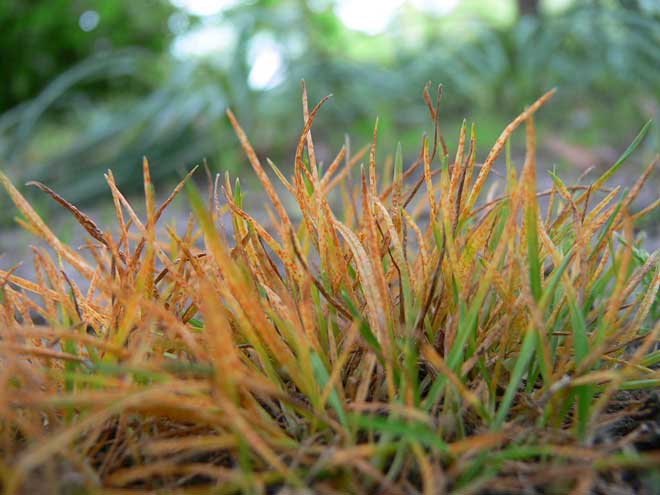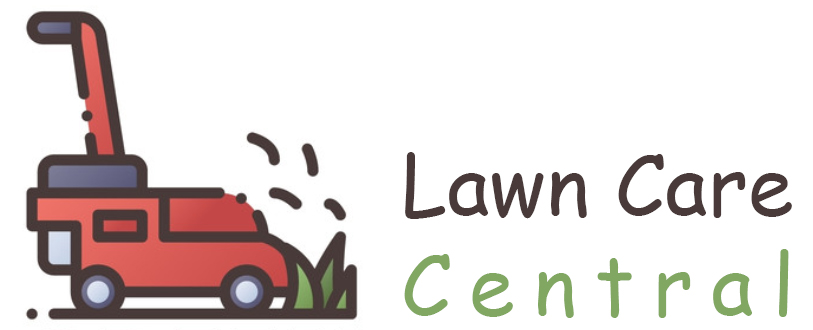If you’ve been noticing a yellow or orange film on your lawn, there’s a good chance you’re dealing with lawn rust. This pesky fungus can cause extensive damage to your grass if left untreated, so it’s important to take action as soon as possible. In this guide, we will discuss how to identify lawn rust, how to treat it, and how to prevent it from coming back.

What Is Grass Rust and How Do I Get Rid of It?
Rust is a type of fungus that can affect several different types of plants, including grasses. Rust usually appears as orange or brown spots on the leaves of the plant, and it can spread quickly if left unchecked. While rust is not generally lethal to grasses, it can weaken the plant and make it more susceptible to other diseases.
If you suspect that your grass has rust, the best course of action is to take a sample of the affected leaves to a local nursery or gardening center for identification. Once you have confirmed that rust is present, there are a few different ways to treat it. For small patches of rust, you can try spot-treating with a fungicide. However, if the rust has spread over a large area, you may need to Apply a systemic fungicide to the entire lawn. With proper treatment, rust can be controlled, and your grass will return to its healthy state.
The Appearance of Grass Rust
Rust is a type of fungal disease that can affect a wide range of plants, including grasses. The disease is characterized by the appearance of reddish-brown to orange-brown spots on the leaves and stems of affected plants.
These spots may eventually coalesce to form large patches of discolored growth. rust can also cause the leaves of affected plants to wilt and die back. In severe cases, the fungus can kill an entire grass plant. While rust is most commonly seen in warm, humid climates, it can occur anywhere there is sufficient moisture for the fungus to thrive.
Will lawn rust go away on its own?
No, unfortunately not. Rust is a type of fungi that thrives in warm, humid conditions. Once it takes hold of your lawn, it can spread quickly, leading to dead patches of grass. The best way to get rid of rust is to treat it with a fungicide. However, this is both costly and time-consuming.
Some people believe that mowing your lawn more frequently will help to get rid of rust. This is because the fungi need long blades of grass to survive. However, mowing will not kill the fungi and is not a recommended method for treating rust. The best way to prevent rust is to water your lawn regularly and fertilize it with a high-nitrogen fertilizer.
What causes rust in a lawn?
There are several reasons why rust might develop in a lawn. Overfertilization is one of the most frequent reasons for plant failure. Inadequately watered plants are another common reason. If the grass is getting too much water, the blades will start to turn yellow or brown. The lawn will also be more susceptible to fungal diseases, which can cause rust. Another common cause of rust is using too much fertilizer. If the fertilizer is high in nitrogen, it can cause the blades to turn yellow or brown.
Too much nitrogen can also make the grass more susceptible to diseases. Finally, rust can also be caused by insects. Some insects, such as chinch bugs, feed on the grass and suck out the juices, which can cause the blades to turn yellow or brown. If you notice any of these symptoms in your lawn, you should take steps to correct the problem as soon as possible.
Is lawn rust harmful to humans?
Lawn rust is a fungal disease that harms grasses. The fungus develops on the blades of grass, causing them to turn yellow or brown. Lawn rust is most common in humid or moist conditions, and it can spread quickly if left untreated. Although lawn rust is unsightly, it is generally not harmful to humans.
However, some people may experience allergic reactions to the fungus, such as skin irritation or respiratory problems. If you have concerns about lawn rust, it is best to consult with a professional landscaper or gardener. They will be able to advise you on the best way to treat the disease and prevent it from spreading.
How Do I Prevent Grass Rust?
Soil is critical for producing healthy plants, as any gardener can tell you. Dandelions are one of the most challenging weeds for gardeners to get rid of since they aggressively compete with other plants, taking away their nutrients and moisture. In addition to providing nourishment and support for roots, it also aids in moisture regulation and weed control.
Tree lings and other grassroots help to hold the soil in place, acting as a dense network of blades that deflect wind and water. In addition, grasses help to slow down the rainwater flow and give the ground a chance to absorb water before it runs off. In other words, if you take good care of your lawn, it will protect against soil erosion.
Also Read: How to Fix a Lawn Full of Weeds: The Ultimate Guide
How to Get Rid of Lawn Rust Without Chemicals
Summer is the time when your lawn should be looking its best. However, sometimes lawn rust can start to appear, ruining the look of your otherwise perfect lawn. Rust is caused by a fungus that thrives in warm, humid conditions. Once it takes hold, it can spread quickly, turning your lawn brown and patchy. Fortunately, there are several things you can do to get rid of rust naturally. One method is to start mowing your lawn more frequently.
This will help to remove infected blades of grass and prevent the fungus from spreading. Another way to fight rust is to water your lawn in the morning instead of the evening. This will give the grass time to dry out before nightfall, making it less susceptible to fungi growth. Finally, make sure to fertilize your lawn regularly. A healthy lawn is better able to resist fungal infections. By following these simple tips, you can keep your lawn looking green and healthy all summer long.
